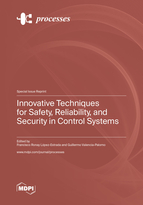Innovative Techniques for Safety, Reliability, and Security in Control Systems
A special issue of Processes (ISSN 2227-9717). This special issue belongs to the section "Automation Control Systems".
Deadline for manuscript submissions: closed (15 April 2023) | Viewed by 28853
Special Issue Editors
Interests: control applications; optimization; LMIs; Takagi–Sugeno; fault diagnosis
Special Issues, Collections and Topics in MDPI journals
Interests: predictive control; optimization; LPV systems; fault detection and isolation
Special Issues, Collections and Topics in MDPI journals
Special Issue Information
Dear Colleagues,
Control systems play a vital role in the advancement of many engineering and science fields. The increasing demand for safety and reliability has led to the development of fault diagnosis (FD) and fault-tolerant control (FTC) systems, which play a paramount role in safety-critical systems, such as water distribution networks, UAVs, aircrafts, spacecrafts, chemical, and biochemical plants, nuclear power plants, to mention a few, where even minor faults can lead to catastrophic consequences. FD has primary importance since it enables online monitoring processes, allowing for the implementation of the so-called active FTC systems. In an active FTC system, the FD module determines which component exhibits abnormal behavior and feeds this information to the controller. Based on this information, it redistributes or adapts the control law to maintain stability with a controlled degradation of the system’s performance. For example, if an unmanned aerial vehicle (UAV) with faulty actuators is considered, the FTC system would redistribute the motors' thrust and torque to avoid collisions that would cause economic losses and harm people, or a potential loss of human lives.
In recent years, the increasing complexity of modern control systems has inspired the scientific community to research systems with particular structures, such as multi-agent systems (MASs), networked control systems (NCSs), and cyberphysical systems (CPSs). These systems allow taking into account the interactions between different agents, as well as the presence of discrete information processing and communication channels. Modern MASs, NCSs, and CPSs have revolutionized several areas and been used with success in many sectors, leading to an increase in overall efficiency and performance. However, at the same time, they have introduced the risk of faults due to non-reliable communication channels, non-neglectable time delays, and cyber attacks, i.e., malicious actions motivated by terrorism, criminality, or cyber warfare, that exploit the system's vulnerabilities and result in some kind of damage. Therefore, there is an increasing interest in creating new techniques or adapting the existing fault diagnosis and fault-tolerant methods to make the above-mentioned systems secure. At the same time, control theory is developing ceaselessly, with continuous production of new theoretical results that wait for their exploitation in innovative fault diagnosis and fault-tolerant control techniques.
This Special Issue on Innovative Techniques for Safety, Reliability, and Security in Control Systems aims to present the most recent advances in the application of advanced mathematics, control theory, and computational algorithms to fault diagnosis, fault-tolerant-control, and secure control.
Original research papers review papers on the state of the art and visionary papers that present new perspectives, ideas, and concepts with potential impact in the future are welcomed.
Potential topics include (but are not limited to):
- Fault diagnosis and fault-tolerant control in control systems;
- Innovative model-based, data-driven, artificial intelligence and statistical techniques for FD and FTC;
- Health, quality, condition and risk monitoring, and their integration with FD and FTC;
- Solutions to problems related to post-fault operation and prevention of fault propagation
Dr. Francisco Ronay López-Estrada
Prof. Dr. Guillermo Valencia-Palomo
Guest Editors
Manuscript Submission Information
Manuscripts should be submitted online at www.mdpi.com by registering and logging in to this website. Once you are registered, click here to go to the submission form. Manuscripts can be submitted until the deadline. All submissions that pass pre-check are peer-reviewed. Accepted papers will be published continuously in the journal (as soon as accepted) and will be listed together on the special issue website. Research articles, review articles as well as short communications are invited. For planned papers, a title and short abstract (about 100 words) can be sent to the Editorial Office for announcement on this website.
Submitted manuscripts should not have been published previously, nor be under consideration for publication elsewhere (except conference proceedings papers). All manuscripts are thoroughly refereed through a single-blind peer-review process. A guide for authors and other relevant information for submission of manuscripts is available on the Instructions for Authors page. Processes is an international peer-reviewed open access monthly journal published by MDPI.
Please visit the Instructions for Authors page before submitting a manuscript. The Article Processing Charge (APC) for publication in this open access journal is 2400 CHF (Swiss Francs). Submitted papers should be well formatted and use good English. Authors may use MDPI's English editing service prior to publication or during author revisions.







